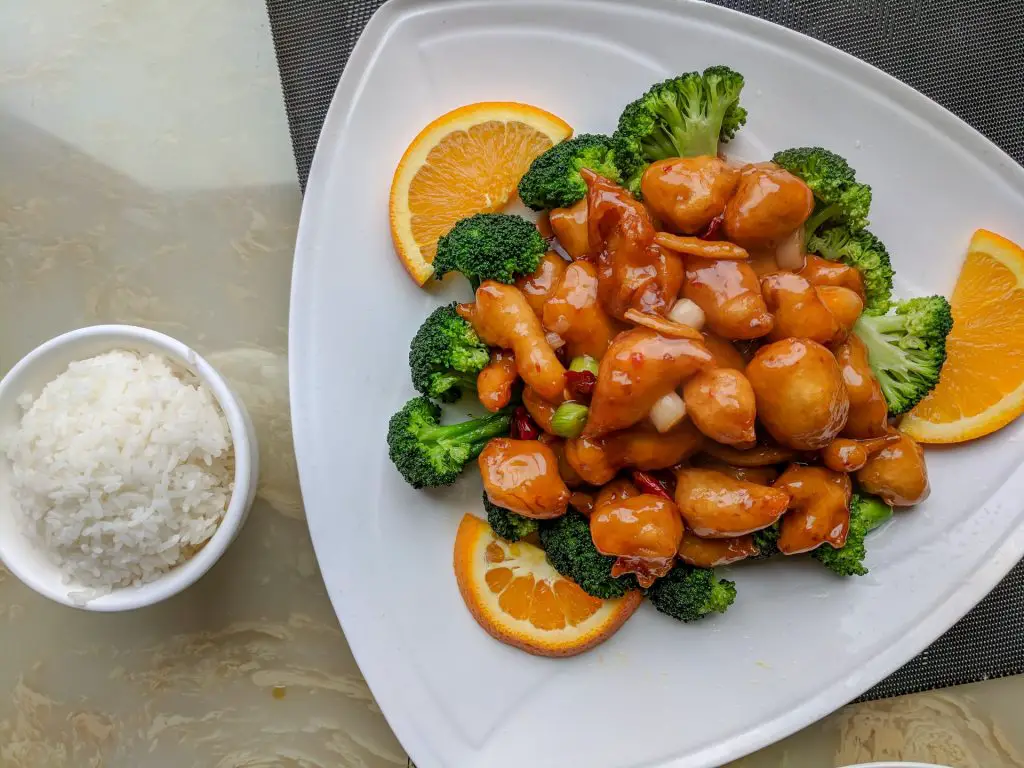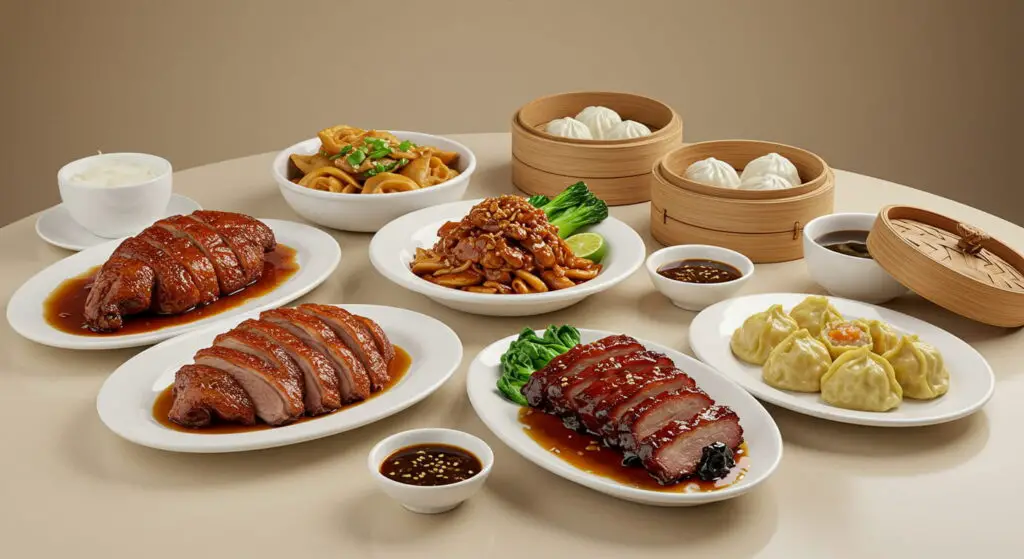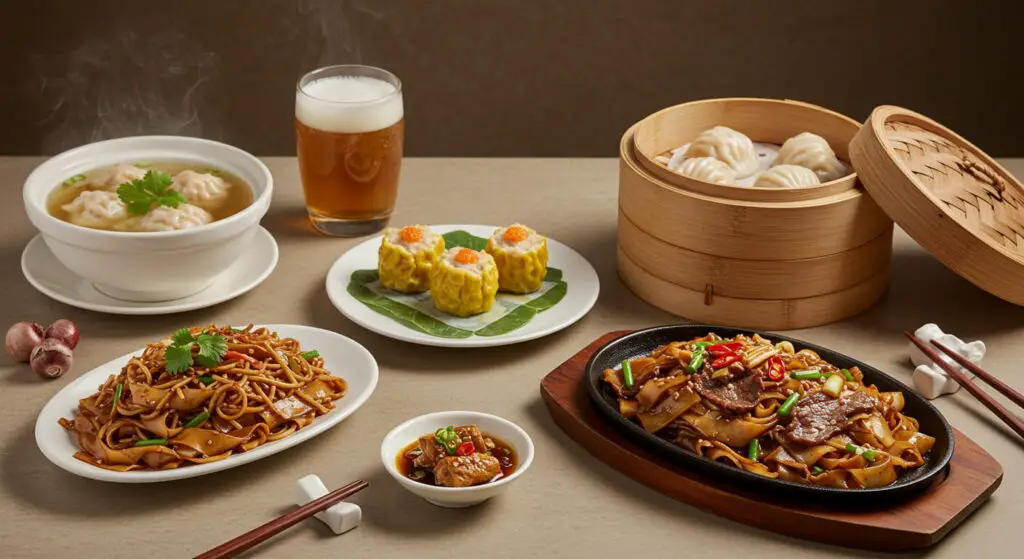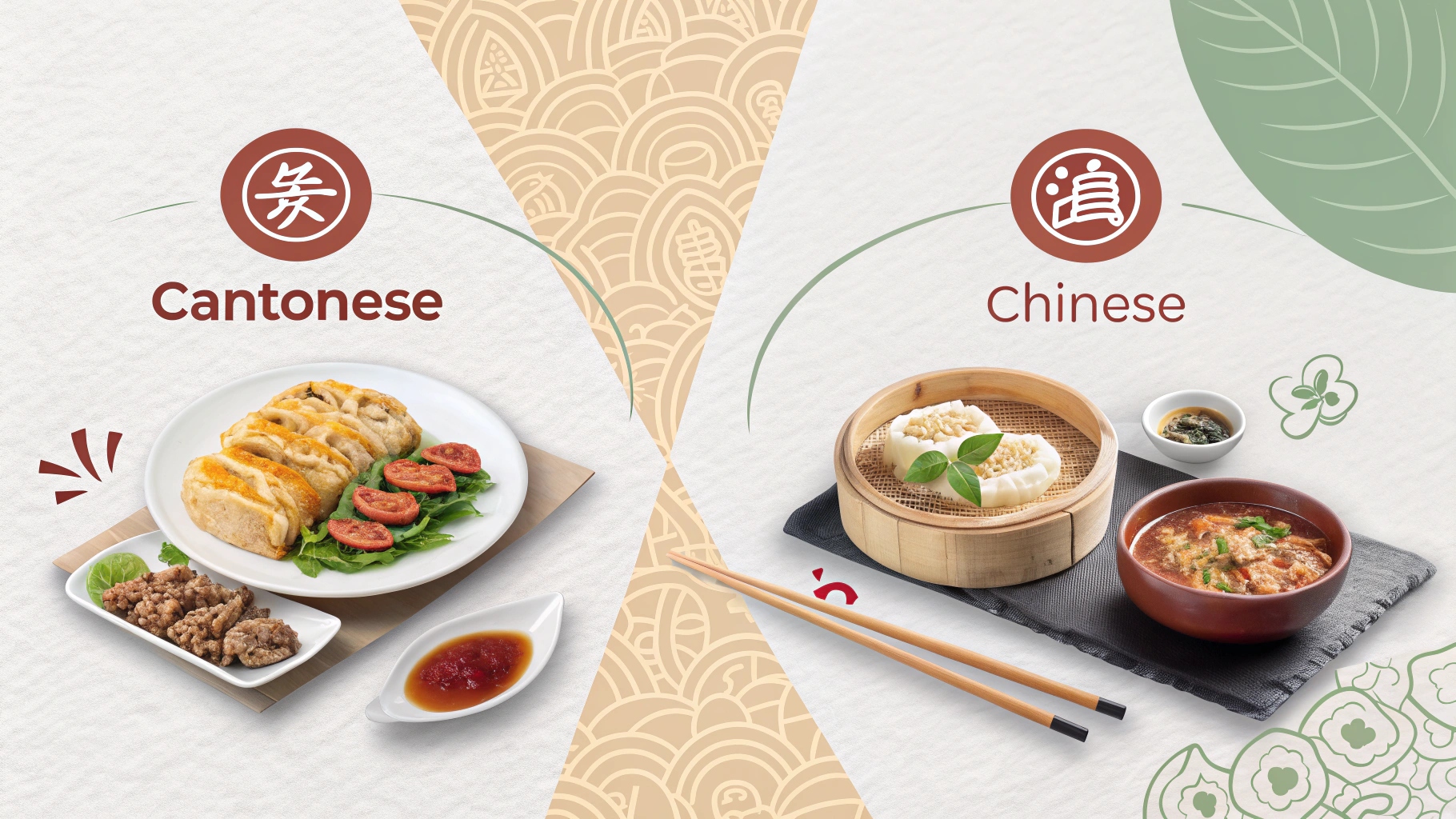Cantonese vs Chinese food. China is a very big country, and therefore, its people have different types of foods or cousins that they consume. When people hear about Chinese food, all that comes to their mind is spicy and sweet foods. Well, this is not the case.
The chinese cook vary from one area to another. Given the diversity of Chinese culture in different parts of the world, you are likely to find yourself in a Chinese restaurant. When such happens, you need to be assured of the exact food you wish to consume. This article will clearly outline more details about Cantonese cuisine and Chinese food.

Table of Contents
Cantonese cuisine
Cantonese cuisine is a part of the Chinese cuisine consumed by the people in the Guangdong province. This cuisine is divided into other cuisines, which include Chaochau, Shunde, Hakka, and Guangzhou. Each of these cuisines is special in its own ways, but the ways of cooking them are similar.
The dishes belonging to Cantonese cuisine are known to be less mild as compared to the dishes from other Chinese cuisines. The unique thing about Cantonese cuisine is its flavor. The chefs ensure that flavor is the main ingredient, and this is what makes their foods different from those consumed in other parts of China. The dishes are balanced and not very greasy. If you have been curious about eating Chinee food and are afraid of how spicy their food is said to be, the Cantonese cuisine would be a great start.
Chinese food
Chinese foods refer to the different types of foods or cuisines consumed by the people of China. However, these foods are no longer consumed by the Chinese only but are also consumed by people from different parts of the world. People have mastered how to prepare different Chinese dishes, and this has made Chinese food one of the most popular foods across the world.
Nearly every country in the world has countable Chinese restaurants that sell to Chinese living in these countries as well as the locals. When people hear about Chinese food, the other thing that comes in their mind is Cantonese cuisines. The truth is that Chinese food has a variety of cuisines, and Cantonese is just one of them. The Chinese cooking style uses soy sauce, garlic, and ginger.
These spices are not often used in most western cuisines. Chinese cooking also includes a lot of vegetables, which makes it unique from cuisines in other parts of the world. Such ingredients make it challenging for people to replicate the exact flavors of Chinese food regardless of how well the chef follows the recipe.
Differences between Cantonese and Chinese food

The main difference between Chinese food and Cantonese cuisine is the origin or the place where these foods are consumed. Cantonese foods are consumed in Guangdong and also originated from this area. On the other hand, Chinese food is consumed in all parts of China. Chinese food refers to any cuisines from different locations in China. Chinese food presents people with a wide range of foods to choose from, while Cantonese dishes are limited.
Another difference is that Cantonese food uses fewer spices and has a mild taste, while the Chinese foods from other parts of the nation are cooked using more spices and tend to be too spicy. The Cantonese dishes do not require the chef to use heating spices such as pepper, ginger, and garlic. If these spices have to be used, they are put in moderation to ensure the food is not very spicy. Other parts of China, such as Szechuan, are well-known for cooking extremely spicy dishes.
Cantonese foods contain an alloy of vegetables and seafood whole other Chinese foods consist of diverse ingredients, with the main ingredient being meat. Although Cantonese cuisines might have meat, most of them are prepared using seafood. A large number of Cantonese people prefer to eat seafood than to eat meat.
Similarities between Cantonese and Chinese food

The main similarity between Cantonese cuisines and Chinese food is that they are all consumed in China. Cantonese is consumed in one of China’s provinces, and this makes it a part of Chinese food. Therefore, when a person tells you about Cantonese cuisines, they are simply talking about specific dishes from China.
Soy sauce and rice are considered the staple food in Cantonese cuisines and Chinese food. Rice and soy sauce are the most popular traditional ingredients used in most Chinese dishes. The Chinese can consume rice daily as long as they serve it with other savory dishes. Rice can be consumed in different ways in both Cantonese cuisine es and in Chinese food. The most famous methods are steaming the rice or using flour to make buns and noodles. Soy sauce is used in almost all dishes to add color and flavor.
The other similarity between Cantonese cuisines and Chinese food is that they are currently being consumed in different parts of the world. Chinese culture has diversified a lot all over the world. The different Chinese foods are part of the cultures that have diversified in different parts of the world. Given that Cantonese cuisine is a part of Chinese foods, individuals can easily eat Chinese food in any restaurant regardless of whether it is Cantonese or not. When you eat Cantonese food in other parts of the world, you will have eaten Chinese food.
The next time you plan on eating Chinese foods, I am sure this article will be of great help. A large number of people do not know that Cantonese cuisines are part of Chinese food. Therefore, this information can help them to easily differentiate between Cantonese cuisines and Chinese food.
If you are one of those people, you will find it easy to determine the type of Chinese food you want to eat without confusing it with something else. Choosing between Cantonese cuisines and Chinese foods depends on an individual’s needs. All the best in choosing your dishes and hoping you will enjoy them regardless of where they are from.
Faqs
1. What is the fundamental difference between Cantonese and general Chinese food?
Cantonese cuisine (from Guangdong) is one of China’s eight great culinary traditions, while “Chinese food” encompasses all regional varieties. Cantonese cooking emphasizes subtle, natural flavors that highlight ingredient freshness, using techniques like quick stir-frying and steaming to preserve textures. In contrast, regions like Sichuan or Hunan feature bold spices and heat. Cantonese food also shows more foreign influence from its port history, incorporating ingredients like oyster sauce less common elsewhere. The cuisine follows the principle of “not letting any single flavor dominate,” creating balanced dishes that differ dramatically from spice-forward regional styles where chilies or numbing peppercorns take center stage.
2. How do the dominant flavors differ between these cuisines?
Cantonese cuisine prioritizes natural umami with gentle sweetness, using oyster sauce, ginger, and scallions. Dishes are lightly seasoned and rarely spicy. Other Chinese regions feature intense profiles: Sichuan’s ma-la (numbing-spicy), Hunan’s fermented heat, or Shandong’s salt-forward tastes. The Cantonese motto “no overpowering flavors” contrasts with Chongqing hot pot’s chili dominance. Cantonese cooking also uses more sugar in savory dishes, creating unique balances like authentic sweet-and-sour pork. Meanwhile, northern cuisines rely on vinegar and garlic, while eastern regions prefer wine-based sauces, making Cantonese flavors distinctly mellower yet more complex in their subtlety.
3. What ingredients are unique or more prominent in Cantonese cuisine?
Signature ingredients include dried shrimp, scallops, napa cabbage, and bok choy. Cantonese chefs use uncommon cuts like smoked duck or black bean spare ribs. Fresh seafood (shrimp, crab) is essential, along with offal (tripe, chicken feet) more than other regions. Unique items are hoisin sauce, salted plum paste, and lotus root. While historically known for exotic meats (snake, civet), modern Cantonese cooking focuses on premium staples like Iberico pork. Their tofu varieties (silken, fried) and rice noodles are more refined than elsewhere. Condiments like fermented black beans add depth without overpowering, embodying the cuisine’s “harmony over heat” philosophy.
4. How do primary cooking techniques differ?
Cantonese chefs master wok hei (“breath of the wok”) – that smoky essence achieved through extreme heat. Quick stir-frying (chao) preserves crunch, while steaming (zheng) shines in dim sum and whole fish. Unique methods include gentle braising (bao) and double-cooking (blanching then searing). Unlike Sichuan’s heavy stews or deep-frying, Cantonese cuisine avoids overcooking vegetables. Their clear broths require meticulous preparation, simmered for hours then strained. Contrast this with northern China’s hand-pulled noodles or eastern China’s red-braising. Cantonese roasting (char siu, crispy pork) also stands apart, using specialized ovens and basting techniques for perfect caramelization.
5. How do rice dishes compare between Cantonese and other Chinese styles?
Cantonese rice dishes like Yangzhou fried rice are light, with distinct ingredients and balanced flavors, using long-grain varieties. Clay pot rice with crispy bottom is iconic. Congee (rice porridge) reaches its zenith here, served with fresh fish or century egg. Other regions feature heavier rice: Fujian’s oyster rice, Sichuan’s spicy toppings, or Xinjiang’s lamb pilaf. Cantonese cuisine also innovated lotus leaf-wrapped sticky rice and “golden fried rice” with egg coating each grain. Unlike northern China’s wheat-based diets or western China’s millet, Cantonese meals always center around perfectly cooked rice – fluffy, not sticky, acting as a canvas rather than just filler.
6. What differences exist in spice and seasoning use?
Cantonese cooking uses spices sparingly: fresh ginger, garlic, scallions, and white pepper form the base. It avoids chili powders typical in Sichuan or Hunan. Their five-spice powder is subtle compared to northern China’s cumin-heavy mixes. Instead, Cantonese cuisine enhances natural flavors with oyster sauce, rice wine, or sesame oil rather than masking them. Fermented black bean sauce adds umami without heat. Notably, Cantonese chefs use more sugar as a balancer – a trait less common in inland regions. This creates a flavor profile the Chinese describe as qing dan (清澹) – clean and mild – allowing ingredients’ true essence to shine through minimal but precise seasoning.
7. How do noodle dishes differ between these cuisines?
Cantonese noodles (like thin rice mei fun or wide ho fun) are lightly cooked to maintain texture. Wonton noodles feature shrimp-pork dumplings in clear broth. Contrast this with northern China’s wheat noodles (hand-pulled lamian) or Sichuan’s dan dan noodles in peanut sauce. Cantonese cuisine boasts unique preparations: e-fu noodles (fried then braised) or longevity noodles for birthdays. Unlike Shanxi’s knife-cut noodles or Lanzhou’s beef noodle soup, Cantonese versions emphasize delicate broth and fresh toppings. Chow fun exemplifies the cuisine’s mastery – broad rice noodles wok-tossed with beef and bean sprouts, achieving perfect smokiness without greasiness, a texture impossible with wheat-based alternatives.
8. What differences exist in pork dishes?
Cantonese pork highlights natural sweetness, like char siu (barbecued pork) glazed with honey and maltose. Unique cuts include spare ribs in black bean sauce or crispy pork belly with crackling skin. Other regions prefer rustic styles (Dongbei’s garlicky boiled pork). Cantonese cuisine features whole roasted suckling pig and offal dishes (organ soup) showcasing nose-to-tail eating. Unlike Sichuan’s twice-cooked spicy pork or Shanghai’s red-braised pork, Cantonese preparations preserve the meat’s juiciness through precise roasting or steaming. Even humble dishes like minced pork with salted fish demonstrate the cuisine’s ability to elevate simple ingredients through technique rather than heavy seasoning.
9. How do chicken preparations vary?
Cantonese chicken epitomizes purity – white cut chicken poached then served with ginger-scallion oil, or salt-baked chicken wrapped in parchment. Steaming and poaching preserve moisture, unlike Yunnan’s tea-smoked chicken or Sichuan’s kung pao. Unique dishes include chicken in lotus leaf or “drunken chicken” marinated in rice wine. Cantonese cuisine utilizes every part: feet in dim sum, bones for broth, even blood for congee. This contrasts with northern China’s heavier roasted chicken or western China’s spicy cold chicken. The iconic beggar’s chicken (clay-baked) demonstrates Cantonese mastery of moist-heat cooking – a technique less common in drier regional styles where frying dominates.
10. What differences exist in vegetarian/vegan dishes?
Cantonese Buddhist vegetarian cuisine innovated meat substitutes using wheat gluten (mock duck) and tofu. Staples like gai lan (Chinese broccoli) with oyster sauce (vegan version exists) showcase vegetable respect. Unlike Sichuan’s mapo tofu or Shandong’s garlicky greens, Cantonese vegetarian dishes emphasize subtlety – braised tofu with mushrooms or winter melon soup. Monasteries developed intricate fermentation techniques for vegetarian “ham” and “fish.” Modern Hong Kong leads vegan dim sum innovation using jackfruit and konjac. This contrasts with inland regions where vegetarianism is simpler – stir-fried greens or cold tofu salads. Cantonese vegetarian banquets can feature over 20 courses mimicking traditional meats through ingenious preparation.
11. How do soup styles differ?
Cantonese soups (tong) are clear, simmered for hours with medicinal herbs like codonopsis root. Winter melon soup or carrot-corn soup exemplify this delicate approach. Unlike Hunan’s thick, spicy soups or Sichuan’s hot-and-sour soup, Cantonese versions are restorative rather than filling. Unique ingredients include dried tangerine peel and snow fungus. The “four herbs soup” is a classic tonic. Cantonese drink soup before meals as digestive aid, not as main course. Seasonal variations – winter lamb soup, summer cooling melon soup – reflect Traditional Chinese Medicine principles. This contrasts with northern China’s hearty mutton soup or eastern China’s seafood bisques, showing how climate shaped regional soup philosophies.
12. What differences exist in beef dishes?
Cantonese beef features in quick stir-fries like ginger-scallion beef with barely pink slices. Tenderloin with bitter melon or beef brisket daikon stew showcase texture contrast. Unlike Sichuan’s spicy beef hot pot or Xinjiang’s cumin lamb, Cantonese preparations emphasize the meat’s natural flavor through minimal seasoning. Unique dishes include beef tendon stew or milk-fed veal. The cuisine avoids lengthy braising that dries out meat, preferring velveting techniques for tenderness. Western-influenced dishes like Cantonese steak (with black pepper sauce) reflect Hong Kong’s colonial history – a fusion unseen inland. Even simple beef chow fun noodles demonstrate the Cantonese ideal: wok-seared freshness where no single ingredient dominates.
13. How do desserts and sweets differ?
Cantonese desserts (tong sui) are less cloying than other Chinese sweets, using red beans, lotus seeds, and fruits. Almond soup or sesame balls exemplify this balanced approach. Unlike Beijing’s candied fruit or Shanghai’s sweet sticky rice, Cantonese sweets often incorporate coconut milk and tropical ingredients. Unique items include double-skin milk pudding or mango pomelo sago. Portuguese-influenced egg tarts showcase foreign adaptations. Dim sum desserts like custard buns or fried sesame balls are globally beloved. The cuisine also features medicinal sweets – snow fungus with pear for coughs, or goji berry soup for vitality. This contrasts with northern China’s heavier pastries or western China’s dairy-based sweets, reflecting regional ingredient availability.
14. What differences exist in egg dishes?
Cantonese cuisine features preserved eggs (century eggs in congee, salted eggs in mooncakes) and silky scrambled eggs (crab meat omelet). Steamed egg custard exemplifies texture mastery. Unlike northern China’s tomato-egg stir-fry or Sichuan’s tea eggs, Cantonese preparations treat eggs as delicate ingredients. Unique dishes include egg white custard with bird’s nest or “golden needle” egg rolls. The cuisine uses egg whites for clarifying broths and yolks for rich sauces – techniques less common elsewhere. Even simple dishes like minced pork with salted fish and steamed egg show the Cantonese philosophy: elevating humble ingredients through precise cooking rather than masking flavors.
15. How did geography shape these culinary differences?
Guangdong’s coastline made seafood central to Cantonese cuisine, while fertile Pearl River Delta provided abundant produce. The tropical climate encouraged light steaming and cooling soups – unlike northern China’s wheat-based, oil-heavy dishes for cold winters. As a historic trade port, Canton absorbed foreign ingredients (oyster sauce from Southern China, coconut from Southeast Asia). This contrasts with landlocked Sichuan’s reliance on preserved foods and chilies to combat humidity. Hong Kong’s colonial period introduced Western baking techniques, creating hybrids like egg tarts. The region’s wealth also allowed premium ingredient access, fostering refined techniques unlike poorer inland areas’ hearty peasant food. Ultimately, Cantonese cuisine reflects its gateway position – adaptable yet distinct, sophisticated yet rooted in freshness.
Read also: Asian gastronomy, Asian Cuisine; Low Sodium Asian Food; Is Asian Food Spicy?; Is Asian Food Gluten Free?; Healthiest Asian Cuisine; South Asian Cuisine 10 Most Popular Recipes; Asian Cuisine Differences; Asian Cuisine History
Editions: Cantonese vs Chinese food
2021-23-25
